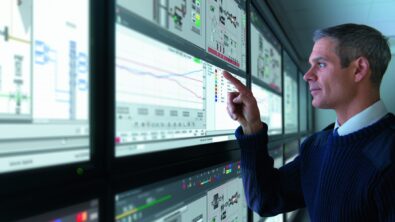How could V2I and connected vehicles change car ownership?

Traffic congestion is a problem all over the world, and it’s getting worse. To reverse this trend, we can’t just add autonomous cars to the road. Siemens believes the most effective way to address this problem is using existing road networks more efficiently through vehicle to infrastructure communication and connected vehicles.
The Siemens Intelligent Traffic Systems (ITS) division is working on this problem and how vehicle to infrastructure communication could contribute to a solution once and for all. I spoke with Marcus Welz, the CEO of Siemens North American ITS division, to learn more. Marcus has been with the ITS division for more than a decade, and he’s worked with international customers in project management, sales and product management roles. In 2007, Marcus even spent time helping the city of Dubai build an advanced traffic management system, which continues to be one of the world’s best.
 I spoke with Marcus Welz, CEO of Siemens’ North American Intelligent Traffic Systems division, for this series.
I spoke with Marcus Welz, CEO of Siemens’ North American Intelligent Traffic Systems division, for this series.
Marcus and I began by discussing how he and the ITS division envision transportation’s future and the challenges that come with that future. We also discussed how the company’s history of innovations in traffic management systems will help as connected cars hit the road, as well as how vehicle to infrastructure (V2I) communication could keep drivers on the road safe.
Until very recently, the movement of cars on our roads has been controlled by individual drivers and their perception of the world within their view and earshot. Apps like Waze have allowed us to increase the purview of our perception as other drivers gives us information about unseen obstacles that lay on the path we are about to take.
Similarly for autonomous cars, you could envision that they’ll eventually be as good as a single human driver, or even a theoretical human driver with many heads and telescopic vision! But this will only be true within the range of the sensor suite. Information the robot driver uses will be enhanced by what other cars provide but with greater accuracy and timeliness that what we get from Waze today. Enhancement will also come from city infrastructure that will supplement car-to-car communication with information about human traffic, or commands from a master control systems that will optimize both pedestrian and traffic flow.
In this final article, Marcus and I talk about how designers and engineers need to prepare for V2I and the future of car ownership.
ED BERNARDON: One of the things that we hear is that, because of autonomous vehicles and mobility as a service, some day we might not even own cars.
So if I could ask you a personal question, or a question as a consumer: what would you have to see, or what would autonomous cars have to prove to you — autonomous cars and all the infrastructure that is around them — what would they have to show you in order for you to give up your car, or do you think that you’ll never give it up?
MARCUS WELZ: No, I would be willing to give up a car if it would be very easy and convenient for me to make that shift to a self-driving vehicle, whether it is shared or not shared, public transport or individual transport.
But today, I think a car is not only an item: it’s an icon. It provides freedom of mobility whenever you’re not sitting in a big traffic jam.
This is a very important topic for me, personally. When I was talking about this third pillar – whenever as user of a car I would be able to plan my trip, book my trip and pay my trip very conveniently, and I could do this with a minimum of a waiting time to have this flexibility – I’d be happy to step away from the steering wheel and use my time more efficiently for more important stuff.
ED BERNARDON: One last question. There’s so much happening in this world of future mobility. People say the words “autonomous cars,” but that’s only one aspect of future transportation. There are many areas of technology development needed to realize the future of transportation.
We will have electric cars, so you need infrastructure to charge cars. You need infrastructure for vehicle to vehicle and vehicle to infrastructure communication, management of traffic across many transportation modes from bikes to trains so that one can rely on getting efficiently and safely from point A to B.
What advice do you have for the engineers of tomorrow so they can prepare for this revolution in transportation?
MARCUS WELZ: Well it would probably be a very simple one, and I would go back to a quote, I think it was Charles Darwin — it is not the strongest or most intelligent who will survive, but it is the one most responsive to change. I think this is exactly where we are today in the transportation arena.
Talking about connected mobility, self-driving vehicles, mobility as a service—we all don’t know exactly where this journey will lead us and we all don’t know how we will move to the future that looks like The Jetsons while we are still now sitting in traffic and have infrastructure that is partially 10 years behind the curve.
I think the key for that is being responsive to that change and open-minded, and a mix between humble and bold, in order to play a role in whichever fashion [you choose], whether this is in an R&D environment, a manufacturing environment, or in a system integration environment; but I think this is what it takes in order to be successful in that arena.

Final thoughts on connected vehicles
As Marcus pointed out, Charles Darwin said that it isn’t the strongest or most intelligent who will survive: it’s the one most responsive to change. The changes we’ll see in the years and decades ahead will transform how we look at cars and transportation.
Vehicle brands and loyalty will probably disappear, and we’ll gradually focus more on the quality, efficiency and cost of getting from point A to point B, not the vehicle itself or what we may still have parked in our garages – if we have garages at all!
Our grandchildren will be amazed that we even allowed unsafe human drivers on the road, and the engineering challenges they’ll face from an automotive perspective will be quite unlike the one automotive engineers have faced in the last 50 or 100 years. We’ll see an automotive perspective made of vehicles, cities and all of the infrastructure, both digital and mechanical, that sews it together.
This concludes my interview series with Marcus Welz. I want to extend a special thank you to Marcus for taking the time to speak with me about the work he and the ITS division of Siemens are doing.
About the author
Edward Bernardon is vice president of strategic automotive initiatives for the Specialized Engineering Software business segment of Siemens PLM Software, a business unit of the Siemens Industry Automation Division. Bernardon joined the company when Siemens acquired Vistagy, Inc. in December, 2011. During his 17 year tenure with Vistagy, Bernardon assumed the roles of vice president of sales, and later business development for all specialized engineering software products. Prior to Vistagy, Bernardon directed the Automation and Design Technology Group at the Charles Stark Draper Laboratory, formerly the Massachusetts Institute of Technology (MIT) Instrumentation Laboratory, which developed new manufacturing processes, automated equipment and complementary design software tools. Bernardon received an engineering degree in mechanical engineering from Purdue University, and later received an M.S. from the Massachusetts Institute of Technology and an MBA from Butler University. He also holds numerous patents in the area of automated manufacturing systems, robotics and laser technologies.


